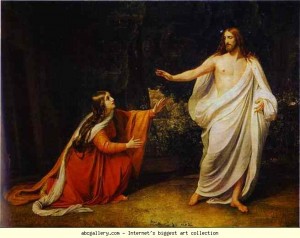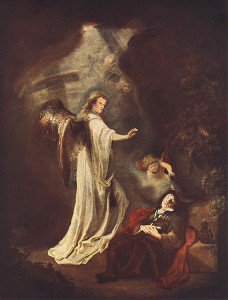A common objection raised by sceptics when considering the plausibility of the resurrection is the alleged inconsistencies inherent within the accounts themselves. Were there two angels or one; did the women witness an earthquake or had it occurred before they arrived: exactly which women turned up at the tomb that Easter morning anyway? For our western, scientifically-orientated way of thinking, these surface contradictions are unsettling and blatant. They seem to indicate a disturbing disregard for precision in the factual reporting of evidence, a disregard that would not be tolerated in our media-driven world today. If there are inconsistencies in the detail, the argument goes, how can we believe with any degree of certainty the actual claim of resurrection itself? Are we not justified, indeed obligated, to question the truth of the event if the eye witnesses themselves couldn’t even sort out surface details?
 It’s an argument that carries weight; indeed one that unsettled me when I first started to read through the gospels. Yet as I continued to think through my concerns, and look at the manuscript tradition, I was repeatedly struck by the obvious: the age of these first century documents. We are dealing here, not with yesterday’s news, but with testimony dating nearly 2000 years ago, testimony that recalls a time and place vastly different from our own. Instead of expecting 21st C precision, would it not be fairer to expect the same sort of historical accuracy we would be looking to find in other 1st C literature?
It’s an argument that carries weight; indeed one that unsettled me when I first started to read through the gospels. Yet as I continued to think through my concerns, and look at the manuscript tradition, I was repeatedly struck by the obvious: the age of these first century documents. We are dealing here, not with yesterday’s news, but with testimony dating nearly 2000 years ago, testimony that recalls a time and place vastly different from our own. Instead of expecting 21st C precision, would it not be fairer to expect the same sort of historical accuracy we would be looking to find in other 1st C literature?
Returning to the gospel accounts themselves, I think we can make several helpful observations. We referred above to the number of angels, the earthquake and the women present. Below, I want to address each discrepancy individually.
Matthew and Mark refer to one single angel; Luke and John claim there were two. Clearly one is not two. However, we have to remember that prior to these events being written down, they were preserved for us through the oral transmission of eye witness testimony. Few people in Jewish society at the time were literate; most relied upon memorisation and re-telling for the transmission of important information. The primary point about angels was not how many there were, but what they actually said. If there had been two angels, but only one had done the talking – which seems more than probable – it seems very reasonable to assume that in relaying the words spoken, oral tradition had dropped as unnecessary the presence of the second silent angel. This does not mean that he was not present; merely that he did not speak.
 All four gospels agree that the women were able to enter the tomb because the stone had been supernaturally rolled away. All four also claim that an earthquake was the cause of the stone’s removal. The discrepancy lies as to when the earthquake took place. Mark, Luke and John all agree the quake was prior to the women’s arrival, while Matthew stands alone in recording it occurred while the women were there, and was witnessed not only by them but by the astounded Roman soldiers. Problematic, maybe, but again I would suggest we not lose sight of the forest for the trees. Matthew goes on to tell us the Roman soldiers left their post (an offence punishable by death) and reported the earthquake to the Chief Priests. They were told to put round the story that the disciples had come and stolen away the body at night while they were sleeping. As an explanation it was weak and scarcely credible, sure to have aroused much jesting throughout Jerusalem inns, for Roman soldiers just didn’t sleep on the job and live to tell the tale, nor did they enjoy the backing of the Jewish governing elite for doing so! Having gone to the trouble of ensuring a closely guarded tomb, why would the Jewish authorities give credence to church leaders by admitting the guard had failed? It’s an absolutely useless piece of apologetic for the authorities to have bandied around unless it was necessary to cover up a more damaging assertion. So the vital question raised isn’t did an earthquake happen before or after the women arrived, but which explanation better accounts for the evidence, because one thing is abundantly clear: something shook up the establishment that day, and it wasn’t just an earthquake.
All four gospels agree that the women were able to enter the tomb because the stone had been supernaturally rolled away. All four also claim that an earthquake was the cause of the stone’s removal. The discrepancy lies as to when the earthquake took place. Mark, Luke and John all agree the quake was prior to the women’s arrival, while Matthew stands alone in recording it occurred while the women were there, and was witnessed not only by them but by the astounded Roman soldiers. Problematic, maybe, but again I would suggest we not lose sight of the forest for the trees. Matthew goes on to tell us the Roman soldiers left their post (an offence punishable by death) and reported the earthquake to the Chief Priests. They were told to put round the story that the disciples had come and stolen away the body at night while they were sleeping. As an explanation it was weak and scarcely credible, sure to have aroused much jesting throughout Jerusalem inns, for Roman soldiers just didn’t sleep on the job and live to tell the tale, nor did they enjoy the backing of the Jewish governing elite for doing so! Having gone to the trouble of ensuring a closely guarded tomb, why would the Jewish authorities give credence to church leaders by admitting the guard had failed? It’s an absolutely useless piece of apologetic for the authorities to have bandied around unless it was necessary to cover up a more damaging assertion. So the vital question raised isn’t did an earthquake happen before or after the women arrived, but which explanation better accounts for the evidence, because one thing is abundantly clear: something shook up the establishment that day, and it wasn’t just an earthquake.
However, even the discrepancy in the timing of the earthquake may only be apparent. It may well be that Matthew’s account is parenthetical, describing an earthquake that took place before the women arrived. John Wenham writes “We have to remember that first century writers had to work without the help of such modern aids as parenthesising brackets, and since Greeks care little about relative time, the use of the pluperfect tense was much less favoured by them than by us. Often in the New Testament the aorist tense needs to be rendered by the English pluperfect. So Matthew 28:2-4 could be inserted in brackets and translated with no impropriety: “And behold there had been a great earthquake. For an angel of the Lord had descended from heaven, and had come and rolled back the stone, and sat upon it…For fear of him the guards had trembled and become like dead men.”[1]
Regarding the women, there is quite remarkable consensus when it comes to which women were present that morning. All four gospel writers tell us Mary Magdalene was present. Mary the mother of James is also listed in Matthew (who calls her “the Other Mary”), Mark and Luke, while John alludes to her presence when he records Mary Magdalene rushing to the disciples with the news, “They have taken the Lord out of the tomb, and we do not know where they have laid him.” (John 20:2). Clearly John does not mean us to take his sole mention of Mary Magdalene as exclusive.
But what about Salome, mentioned by Mark; and Joanna, mentioned by Luke? Here we are given several intriguing insights. The writer Mark is considered by nearly all New Testament historians, regardless of belief, to be very early source material, lacking time for legendary development. Again I would suggest that the presence of Salome in Mark’s account is accurate, yet subsequently dropped in oral transmission.
Luke’s account as a whole appears strikingly different from that of the other synoptic writers. His wording to the women is different as are his instructions. (Luke 24:6,7) Although there are enough links to show that Luke is describing the same happening as the other writers, there are enough discrepancies to suggest he is using a separate oral or literary source. If we suppose there were several independent visitors to the tomb that morning, and such a suggestion would seem plausible enough, would we not be warranted in thinking that over the years, several independent oral sources were preserved to record their experiences? The question then becomes, whose source is Luke using, if not that of the other writers?
It is surely interesting in this respect that Luke alone draws our attention to Joanna, whom he claims also visited the tomb. (Luke 24:10) We know from Luke 8:3 that Joanna’s husband, Chuza, was a manager in the house of Herod Antipas, ruler of Galilee and Peraea. As a prominent and senior member of Herod’s entourage, Chuza and his wife Joanna would have lived in the royal residence which, when in Galilee, would have been in Tiberias, but which, when in Jerusalem, would have been in the Hasmonean Palace, putting them right at the centre of all that went on that Easter weekend. Equally noteworthy for our purposes is Luke’s account of Jesus’ pre-crucifixion interview with Herod, as this detail is again only recorded by Luke, who shows himself particularly well-informed about Herod’s affairs. Putting this information together, it seems entirely plausible that when Luke researched and wrote his gospel he was working from a separate oral tradition, one he received from Joanna, a tradition which may well have been circulating among, and better known to, the gentile population of the time. Luke’s variants, instead of casting suspicion on the gospel accounts, actually serve to strengthen our manuscript tradition.
Drawing this to conclusion then, what are we left with? Do the gospel discrepancies threaten faith, or suggest a faith seriously weakened by history, in conflict with reason? I would suggest not. It seems to me that these discrepancies actually serve to strengthen our faith, for they indicate a multiple source tradition that stands unequalled in the world of manuscript transmission. The Jesus of Easter can stand as both the Jesus of faith and the Jesus of history.
[1] John Wenham, “Easter Enigma: Are the Resurrection Accounts in Conflict?” (Oregon,Wipf&Stock,1992) p.77&78

